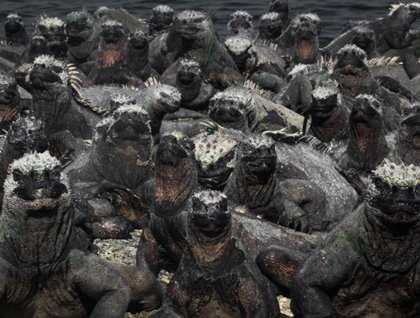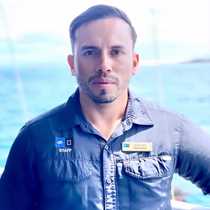Our vessel took us to the western side of this enchanted archipelago. Around the northern snout of this seahorse-shaped island we were welcomed by volcanoes in the far distance and a few ocean birds on the surface of the calm water.
In the early morning hours we took in the stunning views of the volcanoes along the coast of Isabela and we were also in search of sea birds. We crossed the equator line and officially became shellbacks. The National Geographic Islander dropped anchor at Punta Vicente Roca, where the titan cliffs surrounded our visitor site. We decided to go on a Zodiac ride along the tuff cones of this young island. Galapagos penguins and flightless cormorants were seen resting by the shoreline while some marine iguanas were basking in the sun, as others were crawling out of the ocean to join them. After the Zodiac ride we went snorkeling and got to see plenty of pacific green sea turtles. Some were resting on the bottom of the ocean and others were floating on the surface, getting very close to us while we were in the water. We were also lucky to encounter a couple of penguins that were swimming near us.
We soon left our morning site and navigated to Fernandina Island, the youngest of the Galapagos. We had a dry landing at a very prehistoric place known as “Espinoza Point”, where a large number of marine iguanas were sitting right in the middle of our trail. During our hike we spotted small harems of Galapagos sea lions, flightless cormorants nesting and basking near the coastline, and the largest colonies of marine iguanas in the Galapagos. Hundreds were piled up together to retain body heat and to digest the green algae they had previously eaten from the bottom of the ocean. This young island gives us the opportunity to travel back in time, to see the Galapagos without human impact. As the sun was going down, a couple of Galapagos hawks were seen sitting in the red mangrove trees, overseeing the vast lava fields, showing their place at the top of the land food chain on the islands.







